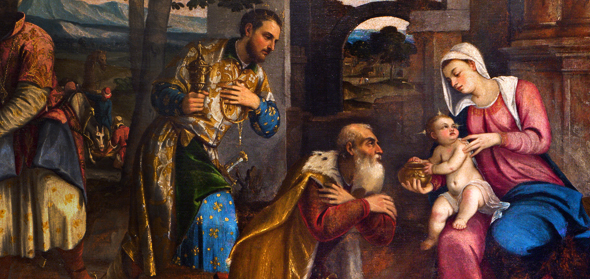
CoinWeek Ancient Coin Series by Mike Markowitz …..
THE NATIVITY OF Jesus is such a familiar image in visual media–from greeting cards to stained glass windows–that it is startling to discover that it does not appear anywhere in Western art until the fourth century, and – with one unique medallic exception – not on coinage until the 16th century. This story takes us outside the usual confines of Ancient and Medieval coins to examine some pieces struck during the Renaissance and Reformation.
But first, some history.
In February 313 CE, Emperor Constantine I issued the Edict of Milan, legalizing Christianity throughout the Roman Empire. Constantine was baptized on his deathbed in 337 and, except for a brief pagan revival under Julian II (ruled 361-363), all subsequent Roman and Byzantine emperors were (at least nominally) Christian.

The image of Christ first appears on a coin in 450, a unique gold solidus struck at Constantinople for the wedding of Emperor Marcian and Pulcheria, the sister of the late Emperor Theodosius II. On the reverse, a haloed figure stands between the bride and groom. The mature couple had no living fathers to solemnize the marriage, so the designer placed the figure of Jesus in the scene; at least that is the interpretation of most experts.
The first mass circulating issue of coins bearing an image of Christ was in 692 for Justinian II (ruled 685-695 and 705-711). The first appearance of the Virgin Mary on a coin came much later, on a rare gold solidus of Leo VI (ruled 886-912).
The Nativity in Early Christian Art

What may be the earliest representation of the Nativity is a detail on the lid of a fourth-century sarcophagus (once thought to be carved for the Roman general Stilicho, who died in 408 CE) in the Basilica of Saint Ambrose in Milan. The infant Jesus, swaddled like a mummy, lies on the manger, flanked by the donkey and the ox. No Mary, no Joseph, no angels, just some decorative birds to fill out the corners. The symbolic animals allude to a passage in the Old Testament book of Isaiah (1:3): “The ox knoweth his owner, and the donkey his master’s manger…”
Charito’s Wedding Medallion
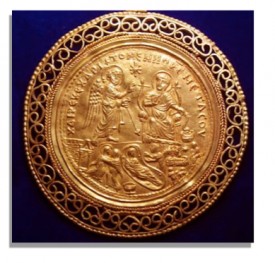 The earliest numismatic appearance of a nativity scene may be on a unique gold medallion issued for the wedding of princess Charito, daughter of Emperor Tiberius II Constantine (ruled 574-582 CE), who married an army commander, Germanos, around Christmas in 583. Struck by the imperial mint in Constantinople, this massive 90-gram medallion was not strictly a coin, but the weight corresponds to 20 solidi. A miniature representation of the Nativity appears on the lower register of the obverse (beneath a more prominent scene of the Annunciation). Mary reclines on a couch, attended by a midwife. In the background the tightly wrapped baby Jesus is nuzzled in the manger by the ox and donkey, beneath a star. The piece is spectacular, but the composition is overcrowded and the design was clearly too ambitious for the skill of the artist.
The earliest numismatic appearance of a nativity scene may be on a unique gold medallion issued for the wedding of princess Charito, daughter of Emperor Tiberius II Constantine (ruled 574-582 CE), who married an army commander, Germanos, around Christmas in 583. Struck by the imperial mint in Constantinople, this massive 90-gram medallion was not strictly a coin, but the weight corresponds to 20 solidi. A miniature representation of the Nativity appears on the lower register of the obverse (beneath a more prominent scene of the Annunciation). Mary reclines on a couch, attended by a midwife. In the background the tightly wrapped baby Jesus is nuzzled in the manger by the ox and donkey, beneath a star. The piece is spectacular, but the composition is overcrowded and the design was clearly too ambitious for the skill of the artist.
It was almost a thousand years before the image of the Nativity appeared again on a coin.
Clement VII’s Holy Year
 Born about 1478 in Florence, Giulio de’ Medici, nephew of Lorenzo “the Magnificent”, was elected pope on November 19, 1523, choosing the name Clement VII. He was a patron of artists like Raphael, Michelangelo and Cellini.
Born about 1478 in Florence, Giulio de’ Medici, nephew of Lorenzo “the Magnificent”, was elected pope on November 19, 1523, choosing the name Clement VII. He was a patron of artists like Raphael, Michelangelo and Cellini.
In 1525, with Europe wracked by the Protestant Reformation, he proclaimed a Holy Year and commissioned a special issue of commemorative coins, including a very rare gold five-ducat piece and a silver quarter-ducat (about 9.2 grams). The reverse shows the pope wielding a ceremonial pick to open the bricked-up Holy Door of St. Peter’s, while in the clouds above St. Peter with his key unlocks the gate of Heaven. The obverse is our familiar Nativity scene, surrounded by the Latin inscription Hodie Salus Facta Est Mundo (“Today the Salvation of the World is Accomplished”).
Most surviving examples of this coin have been pierced or mounted as devotional medals. Extremely fine pieces have sold for $2,500-3,000 in recent auctions.
The origin of this depiction of the Nativity was a Christmas pageant with live actors staged by St. Francis of Assisi in 1223. As the presepio (Italian for “manger” or “crib”), it figures in countless works of folk art, sculpture, and painting from the late middle ages through the Renaissance until the present. It took 50 more years before another papal coin depicted the Nativity.
Gregory XIII
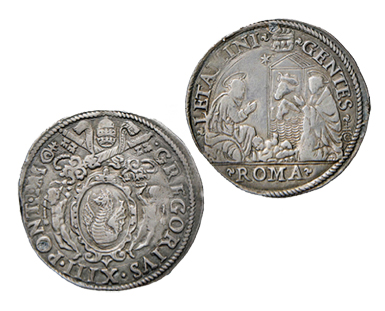 Born to an aristocratic family in Bologna in 1502, Ugo Boncompagni was elected pope on May 13, 1572, choosing the name Gregory XIII. He is best known for his reform of the Julian calendar, which had drifted out of sync with the seasons. The calendar we use is still called “Gregorian”.
Born to an aristocratic family in Bologna in 1502, Ugo Boncompagni was elected pope on May 13, 1572, choosing the name Gregory XIII. He is best known for his reform of the Julian calendar, which had drifted out of sync with the seasons. The calendar we use is still called “Gregorian”.
Although Gregory’s coinage is abundant, an undated silver testone depicting the Nativity is quite rare – with most surviving examples pierced or mounted for wear as religious medallions. The testone, introduced in 1545, was a high-quality silver coin that replaced the quarter ducato. The design shows the growing confidence and skill of papal mint engravers: the infant Jesus has the proportions of a baby, and the drapery of the robes worn by Joseph and Mary reflects their worshipful posture. The inscription LETAMINI GENTES translates as “You nations, rejoice.”
This appears to be the only other papal coin before the year 1700 that shows a Nativity scene. For further Christmas examples, we must go north of the Alps, to the German-speaking lands.
Wolfgang Roll
Early in the 16th century, a massive deposit of silver ore was discovered near the Bohemian mountain town of Joachimsthal (now Jáchymov, Czech Republic). The large silver coins (about 26 grams) struck there circulated globally and became known as thalers or talers, from which our word “dollar” is derived. Wolfgang Roll, a talented die cutter and goldsmith from Kremnitz in Slovakia, served as mint master there in the 1550s. He executed at least two coin designs showing the Nativity–probably special issues intended as prestigious Christmas gifts at the court of Habsburg emperor Ferdinand I (who ruled as king of Bohemia 1526-1564).
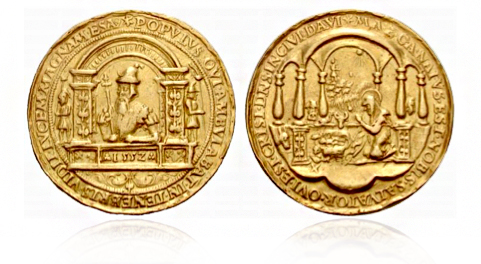 On a unique gold four-ducat piece, struck from dies prepared for a silver quarter guldiner, the obverse shows the prophet Isaiah, incongruously dressed as a 16th-century noble, surrounded by the Latin text of his words: “The people that walked in darkness have seen a great light” (Isaiah, 9:2; cited in Matthew, 4:16).
On a unique gold four-ducat piece, struck from dies prepared for a silver quarter guldiner, the obverse shows the prophet Isaiah, incongruously dressed as a 16th-century noble, surrounded by the Latin text of his words: “The people that walked in darkness have seen a great light” (Isaiah, 9:2; cited in Matthew, 4:16).
The reverse places the Nativity beneath an elaborate arched vault, perhaps based on pilgrims’ descriptions of the grotto beneath the Church of the Nativity in Bethlehem. The ox peers over a low wall, and the donkey’s head pokes in from the left. In the background on a hill, we see a shepherd with a flock of tiny sheep. The Latin inscription around the scene paraphrases Luke, 2:11: “Born to us in the City of David, a Savior Who is Christ the Lord.”
In a 2005 auction, this coin brought over US$10,750. An example in silver from the same dies brought about $3,000. In 2007, a heavily worn and damaged specimen that had once been gilded sold for only 160 euros (then about $213).
On a gold ducat by the same master engraver (dated 1554), the obverse shows the kneeling Lamb of God; the Nativity scene on the reverse is compressed to fit the more restricted space. The surrounding inscription is the Latin text of Isaiah, 9:6 – “Unto us a child is born,” adding the words “by the name of Jesus.” In a 2004 auction, this coin sold for US$4,000.
Münster
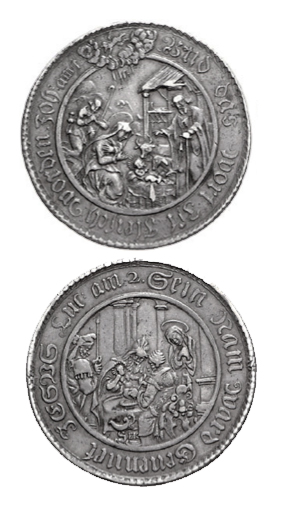 Located in the north German region of Westphalia, the city of Münster (not to be confused with the Irish province or the TV family) was a battleground in the savage religious conflict of the Thirty Years’ War (1618-1648). It was eventually held for the Catholic side by its powerful prince-bishop, Ferdinand von Bayern (1611-1650). Between 1638 and 1647 the city issued a series of silver coins denominated at three-quarters and one and a half thaler.
Located in the north German region of Westphalia, the city of Münster (not to be confused with the Irish province or the TV family) was a battleground in the savage religious conflict of the Thirty Years’ War (1618-1648). It was eventually held for the Catholic side by its powerful prince-bishop, Ferdinand von Bayern (1611-1650). Between 1638 and 1647 the city issued a series of silver coins denominated at three-quarters and one and a half thaler.
These “schautaler” or “doppelte schautaler” were probably intended as Christmas gifts. The obverse Nativity scene is surrounded by a German inscription that translates as “…and the Word became Flesh” (John, 1:4). The unusual reverse depicts the Circumcision of Jesus, with the corresponding text from Luke, 2:21: “…His name was called Jesus.”
A superb toned example of this coin brought US$4,500 in a 2007 German auction. Other examples of this relatively common type have sold in recent years for prices ranging from $276 to $1,530.
Hamburg
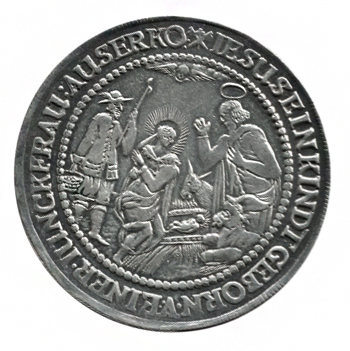 The great north German seaport of Hamburg also issued an extensive series of silver Christmas schautaler. Undated, they were struck from 1635 to 1668 in denominations ranging from one-quarter taler and two taler. Most are executed in a vigorous, crude style reflecting folk-art traditions. For example, the shepherd who appears on the left is dressed in 17th-century garb. The winged head of an angel peers down from the clouds above. The reverse shows the baptism of Christ.
The great north German seaport of Hamburg also issued an extensive series of silver Christmas schautaler. Undated, they were struck from 1635 to 1668 in denominations ranging from one-quarter taler and two taler. Most are executed in a vigorous, crude style reflecting folk-art traditions. For example, the shepherd who appears on the left is dressed in 17th-century garb. The winged head of an angel peers down from the clouds above. The reverse shows the baptism of Christ.
These Hamburg issues may be the most common and affordable numismatic representations of the Nativity from before 1700, typically selling for a few hundred up to 1,500 dollars. There are also very rare strikes in gold.
Why So Few?
Why was the depiction of the Nativity so uncommon on coins before the 17th century? After all, for believers this was the cosmic, defining event of history. A few 13th-century coins show the Annunciation, and some Byzantine seals and rare medallions show the Adoration of the Magi, but a search for the Nativity on actual coins uncovers remarkably few examples.
In order to depict something like the Nativity effectively on the small compass of a coin, the artist must have a mastery of visual storytelling. This ability was lost in the breakdown of the classical world. Medieval die cutters could barely manage a simple stick figure. The skills of composition, perspective and sculptural rendering in low relief were not rediscovered until the Renaissance.
More importantly, the bosses who told the engravers what to cut were not necessarily interested in storytelling, even of the most exalted kind. They wanted to promote their power, and associate themselves with religious symbols. Emperors, kings, popes and bishops who lived in palaces might have felt somewhat uneasy reminding their subjects that the “Greatest Story Ever Told” concerned a poor Woman who gave birth in a stable.
* * *
References
Berman, Allen. Papal Coins. Attic Books (1991)
Breckinridge, James. The Numismatic Iconography of Justinian II. American Numismatic Society. (1959)
Matthews, Thomas F. The Clash of Gods: A reinterpretation of Early Christian Art. Princeton. (1993)
Ryan, John Carlin. A Handbook of Papal Coins. Washington, D.C. (1989)
“The Nativity in Art”. http://en.wikipedia.org/wiki/Nativity_of_Jesus_in_art
* * *




